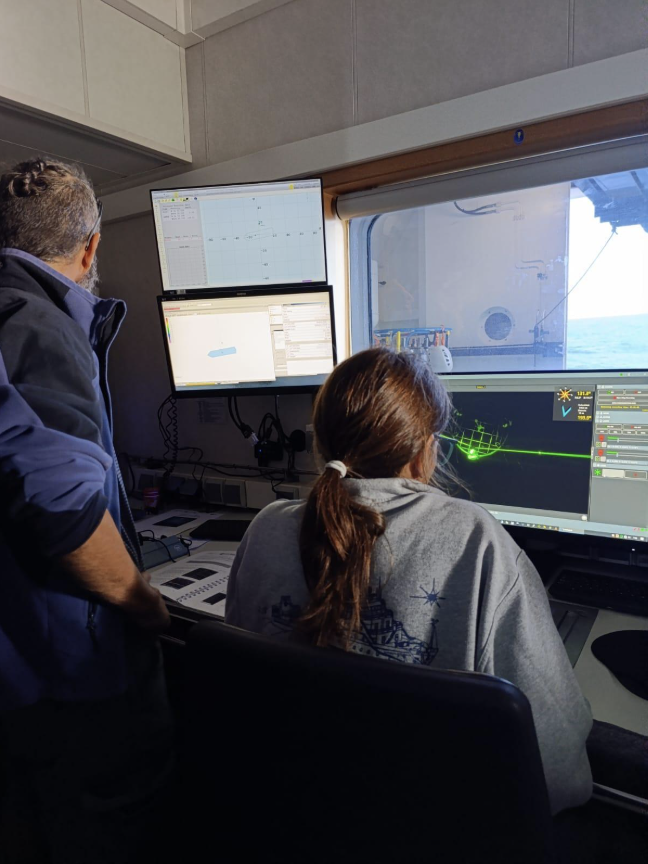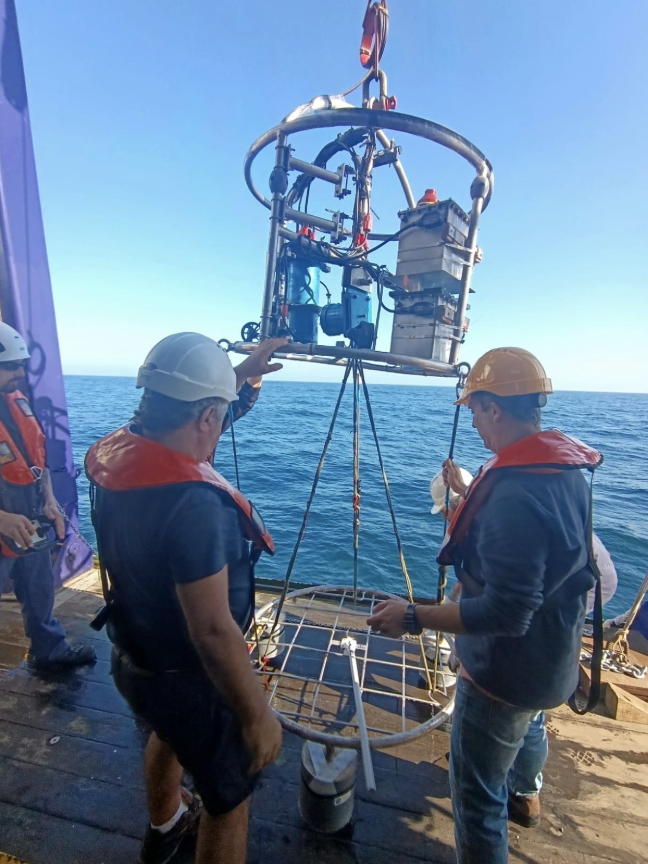A new initiative underway within the EMSO Physical Access in the ERIC’s Portuguese Regional Facility is testing a game-changing system that makes deploying and retrieving scientific instruments more precise and cheaper, ending the costly “high-stakes gamble” of open sea monitoring.
Off the coast of Portugal, a new initiative is tackling one of the biggest challenges in marine science: the high cost and logistical complexity of monitoring the seafloor environment at the EMSO Iberian Margin Regional Facility.
The Low-cost landers for complementary sustained near-bed monitoring at EMSO deep sites (LOCOLAND) project, granted within the EMSO Physical Access Programme and hosted at the Iberian Margin Regional Facility, is testing an innovative system designed to radically optimise the deployment and subsequent recovery of ocean benthic landers, invaluable instruments for the scientific community to study remote and deep-ocean environments.
We explored this promising initiative with César González-Pola, Senior Scientist at the Spanish Institute of Oceanography (IEO-CSIC) and Principal Investigator of the LOCOLAND project.
The Challenge: A High-Stakes Gamble in the Deep Sea
For decades, oceanographic campaigns have involved a high-stakes gamble. Traditionally, the expensive and autonomous benthic landers are simply deployed into the seabed, free-falling for miles to the ocean floor with no guarantee of landing in the precise target location, as even a slight current, even a few miles from the surface, can cause the lander to drift significantly by the time it reaches the seafloor. Recovery is an equally blunt and costly affair: an acoustic signal commands the lander to jettison heavy ballast, permanently littering the pristine seafloor, just to float the lander back to the surface. This method is imprecise, wasteful, and prohibitively expensive for many research teams. “You have only a few days to deploy and retrieve equipment that has taken months or even years to prepare,” González-Pola notes. “Those few days make the difference between your project’s success or failure.”
The LOCOLAND Innovation: LanderPick system
The LOCOLAND project, led by IEO-CSIC, introduces a smarter approach for ocean lander operations. Using a remotely operated system, scientists can now guide the lander to a precise location with visual confirmation. The recovery process is equally precise, using a specialised grappling mechanism that brings the entire unit back to the surface, leaving nothing behind. It is the LanderPick (LP) concept, a field-proven technology developed by IEO-CSIC across multiple projects starting in 2020.“The LanderPick concept entails the development of a specific, cost-effective, and compact Remote Operated Towed Vehicle (ROTV) capable of accurately carrying a payload to be placed and hitched with visual assistance and LanderPick-suited landers devoid of built-in recovery elements, but equipped with a cobweb mechanism for easy hitching. The use of a built-in recapture mesh to hook a lander represents a novel advancement since no similar strategy had been attempted before. The feasibility of this system has only become achievable due to recent breakthroughs in vessel dynamic positioning and underwater positioning systems, gradually integrated into oceanographic fleets”, specifies González-Pola.
The LanderPick system has already been successfully used in over 200 operations by the IEO fleet, deploying more than 40 landers of different shapes and payloads (weighing up to 300 kg) in the Mediterranean and Atlantic.
LOCOLAND in Action: Proving the LanderPick system’s versatility
Two landers, equipped with cost efficient instruments such as a tilt current meter and a temperature sensor, have been deployed at the Iberian Margin Regional Facility and at the depth of approximately 200m, over the continental shelf break. Two more will be deployed during a mission scheduled for mid-2026 on the Portuguese Research Vessel Mario Ruivo.
The primary goal of the LOCOLAND project is to advance the system’s Technology Readiness Level (TRL), a formal measure of technological maturity, of the LanderPick system. By testing it on different vessels, the team can demonstrate its adaptability to different ships and technologies, making the LanderPick system a promise to make deep-sea science more accessible, affordable, and sustainable. Moving the LanderPick system to a new vessel like the R/V Mario Ruivo presents several challenges: “Our first and most immediate hurdle is technical compatibility. Every ship is different, so our foundational challenge is ensuring our system can seamlessly integrate with the R/V Mario Ruivo’s unique infrastructure, achieving that perfect digital and physical handshake. We have already conducted successful communication tests, confirming that the system can interact with the ship’s onboard systems. Next, we aim to tackle operational adaptation to handle the system’s high-precision manoeuvres on an unfamiliar vessel. And finally, the performance validation, the ultimate phase. We had to confirm that the system worked just as reliably and accurately on the new ship and under the specific environmental conditions of the EMSO Iberian Margin site” specifies González-Pola.

Fig. 1: The LOCOLAND team deploys a benthic lander. Credits: Spanish Institute of Oceanography
Fig. 2: LanderPick (LP) concept in action for guiding the precise deployment of the benthic lander on the seafloor. Credits: Spanish Institute of Oceanography
Author: Sara Pero, EMSO ERIC


